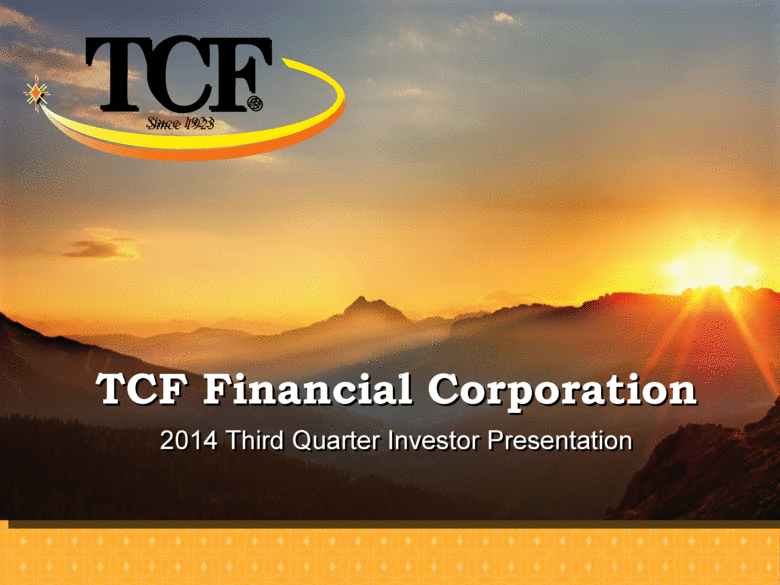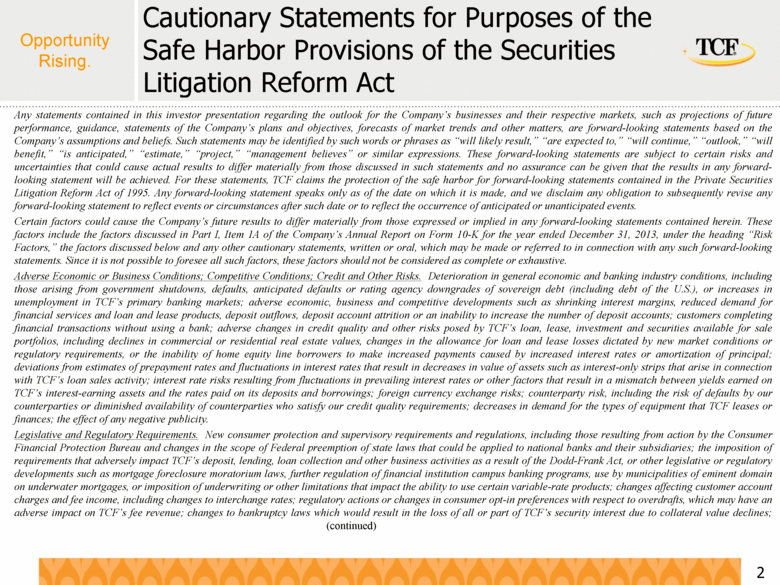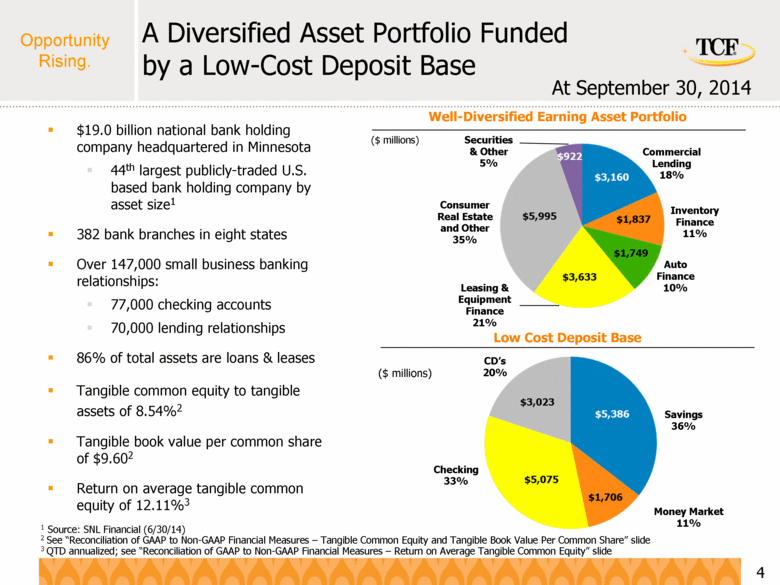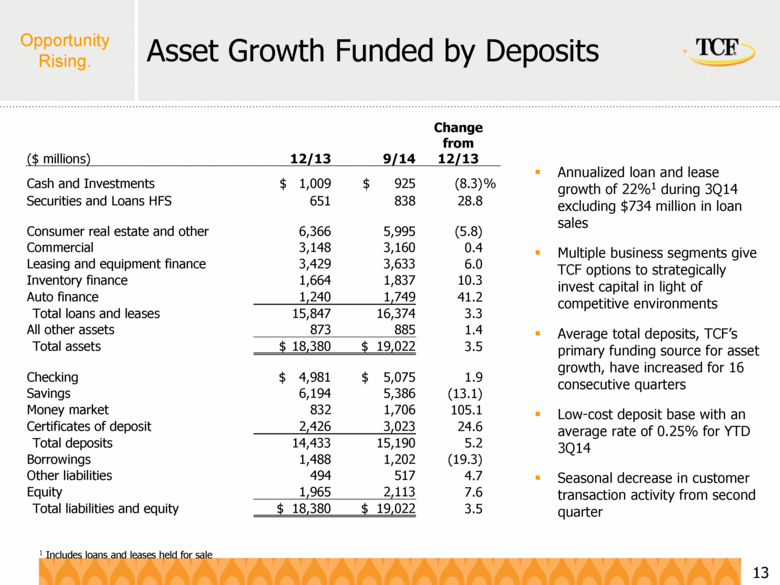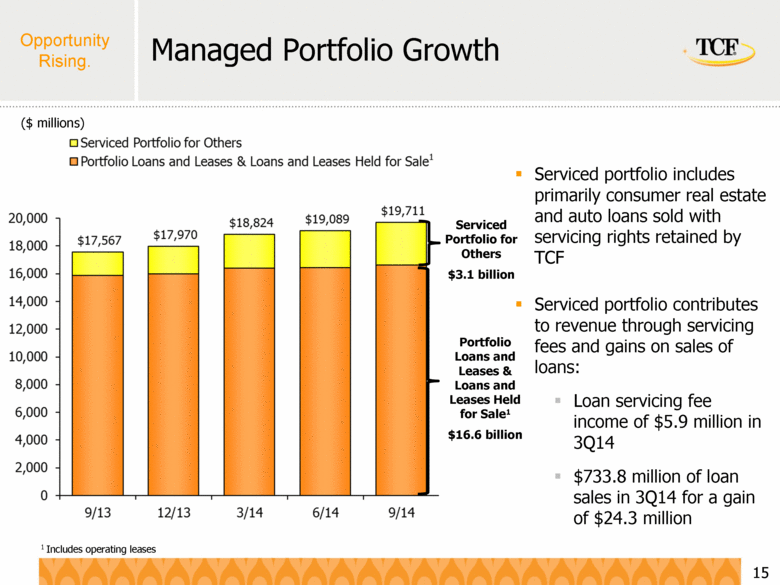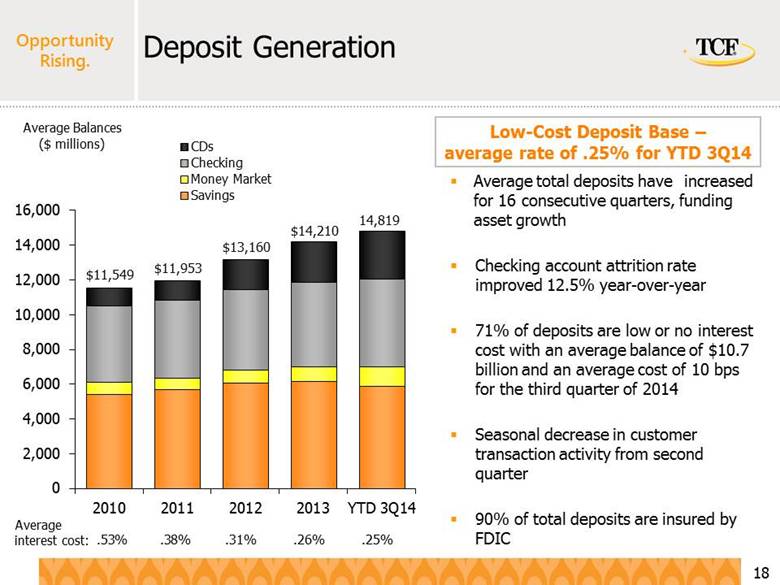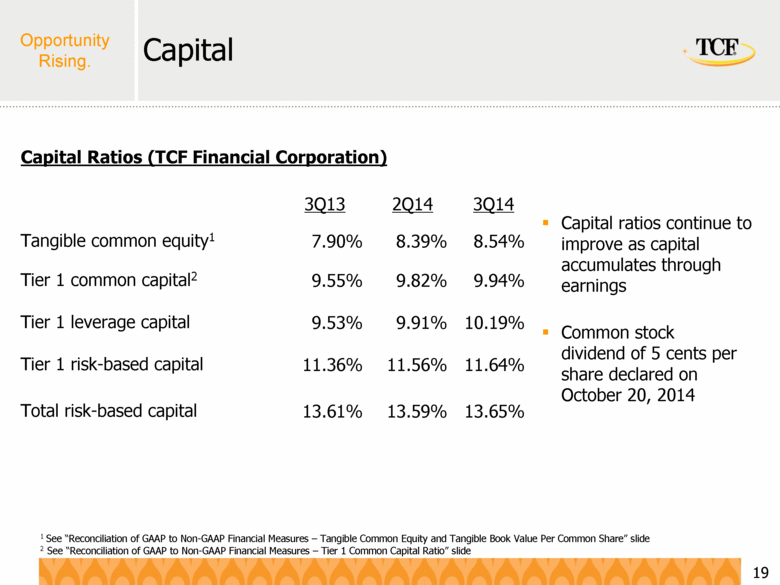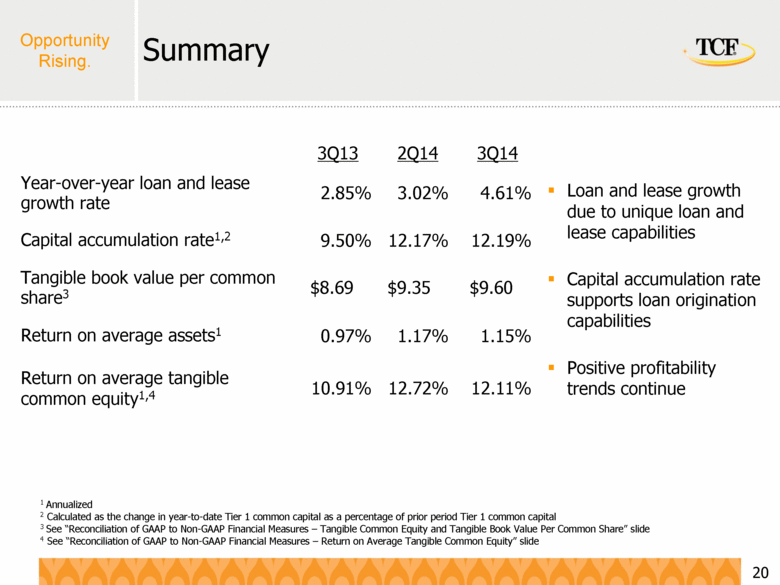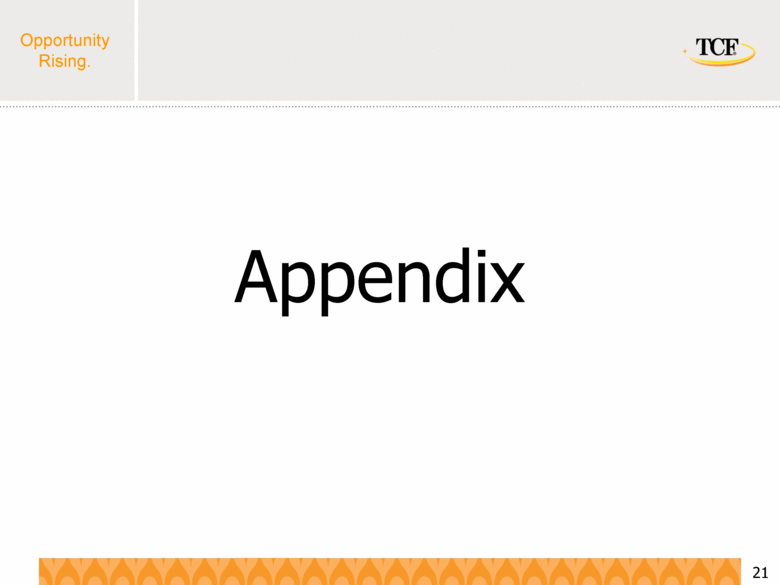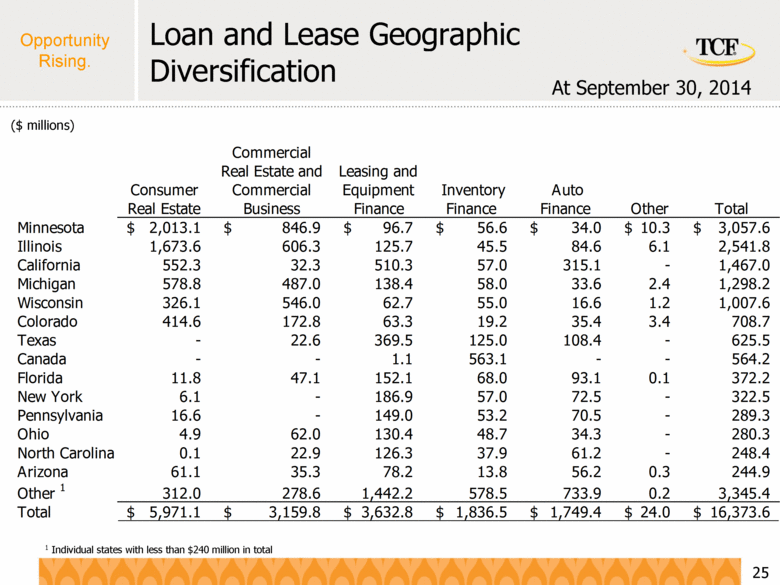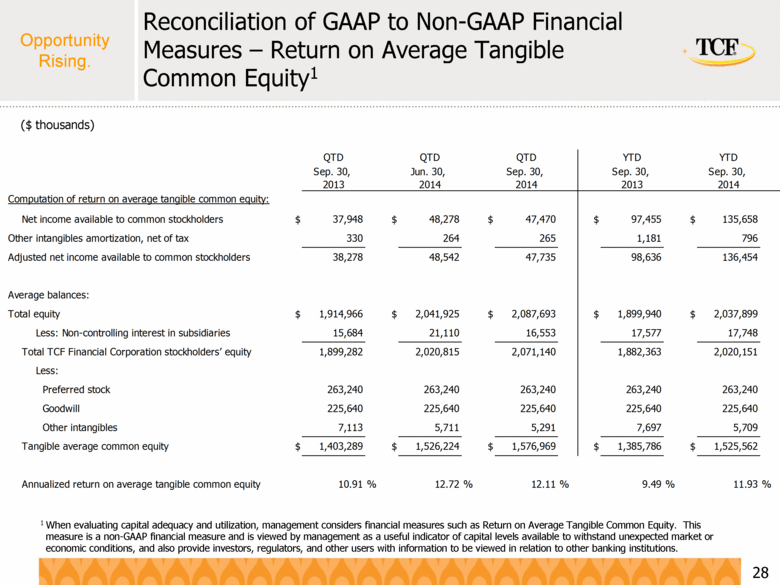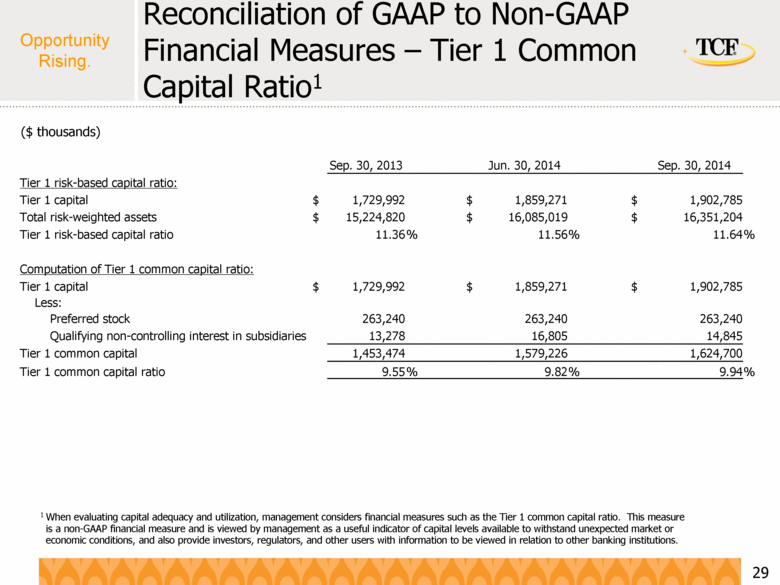Attached files
| file | filename |
|---|---|
| 8-K - 8-K - TCF FINANCIAL CORP | a14-23574_18k.htm |
Exhibit 99.1
|
|
TCF Financial Corporation 2014 Third Quarter Investor Presentation |
|
|
Cautionary Statements for Purposes of the Safe Harbor Provisions of the Securities Litigation Reform Act Any statements contained in this investor presentation regarding the outlook for the Company’s businesses and their respective markets, such as projections of future performance, guidance, statements of the Company’s plans and objectives, forecasts of market trends and other matters, are forward-looking statements based on the Company’s assumptions and beliefs. Such statements may be identified by such words or phrases as “will likely result,” “are expected to,” “will continue,” “outlook,” “will benefit,” “is anticipated,” “estimate,” “project,” “management believes” or similar expressions. These forward-looking statements are subject to certain risks and uncertainties that could cause actual results to differ materially from those discussed in such statements and no assurance can be given that the results in any forward-looking statement will be achieved. For these statements, TCF claims the protection of the safe harbor for forward-looking statements contained in the Private Securities Litigation Reform Act of 1995. Any forward-looking statement speaks only as of the date on which it is made, and we disclaim any obligation to subsequently revise any forward-looking statement to reflect events or circumstances after such date or to reflect the occurrence of anticipated or unanticipated events. Certain factors could cause the Company’s future results to differ materially from those expressed or implied in any forward-looking statements contained herein. These factors include the factors discussed in Part I, Item 1A of the Company’s Annual Report on Form 10-K for the year ended December 31, 2013, under the heading “Risk Factors,” the factors discussed below and any other cautionary statements, written or oral, which may be made or referred to in connection with any such forward-looking statements. Since it is not possible to foresee all such factors, these factors should not be considered as complete or exhaustive. Adverse Economic or Business Conditions; Competitive Conditions; Credit and Other Risks. Deterioration in general economic and banking industry conditions, including those arising from government shutdowns, defaults, anticipated defaults or rating agency downgrades of sovereign debt (including debt of the U.S.), or increases in unemployment in TCF’s primary banking markets; adverse economic, business and competitive developments such as shrinking interest margins, reduced demand for financial services and loan and lease products, deposit outflows, deposit account attrition or an inability to increase the number of deposit accounts; customers completing financial transactions without using a bank; adverse changes in credit quality and other risks posed by TCF’s loan, lease, investment and securities available for sale portfolios, including declines in commercial or residential real estate values, changes in the allowance for loan and lease losses dictated by new market conditions or regulatory requirements, or the inability of home equity line borrowers to make increased payments caused by increased interest rates or amortization of principal; deviations from estimates of prepayment rates and fluctuations in interest rates that result in decreases in value of assets such as interest-only strips that arise in connection with TCF’s loan sales activity; interest rate risks resulting from fluctuations in prevailing interest rates or other factors that result in a mismatch between yields earned on TCF’s interest-earning assets and the rates paid on its deposits and borrowings; foreign currency exchange risks; counterparty risk, including the risk of defaults by our counterparties or diminished availability of counterparties who satisfy our credit quality requirements; decreases in demand for the types of equipment that TCF leases or finances; the effect of any negative publicity. Legislative and Regulatory Requirements. New consumer protection and supervisory requirements and regulations, including those resulting from action by the Consumer Financial Protection Bureau and changes in the scope of Federal preemption of state laws that could be applied to national banks and their subsidiaries; the imposition of requirements that adversely impact TCF’s deposit, lending, loan collection and other business activities as a result of the Dodd-Frank Act, or other legislative or regulatory developments such as mortgage foreclosure moratorium laws, further regulation of financial institution campus banking programs, use by municipalities of eminent domain on underwater mortgages, or imposition of underwriting or other limitations that impact the ability to use certain variable-rate products; changes affecting customer account charges and fee income, including changes to interchange rates; regulatory actions or changes in consumer opt-in preferences with respect to overdrafts, which may have an adverse impact on TCF’s fee revenue; changes to bankruptcy laws which would result in the loss of all or part of TCF’s security interest due to collateral value declines; (continued) |
|
|
Cautionary Statements for Purposes of the Safe Harbor Provisions of the Securities Litigation Reform Act (continued) deficiencies in TCF’s compliance under the Bank Secrecy Act in past or future periods, which may result in regulatory enforcement action including monetary penalties; increased health care costs resulting from Federal health care reform legislation; regulatory criticism and resulting enforcement actions or other adverse consequences such as increased capital requirements, higher deposit insurance assessments or monetary damages or penalties; heightened regulatory practices, requirements or expectations, including, but not limited to, requirements related to enterprise risk management, the Bank Secrecy Act and anti-money laundering compliance activity. Earnings/Capital Risks and Constraints, Liquidity Risks. Limitations on TCF’s ability to pay dividends or to increase dividends because of financial performance deterioration, regulatory restrictions or limitations; increased deposit insurance premiums, special assessments or other costs related to adverse conditions in the banking industry, the economic impact on banks of the Dodd-Frank Act and other regulatory reform legislation; the impact of financial regulatory reform, including additional capital, leverage, liquidity and risk management requirements or changes in the composition of qualifying regulatory capital (including those resulting from U.S. implementation of Basel III requirements); adverse changes in securities markets directly or indirectly affecting TCF’s ability to sell assets or to fund its operations; diminished unsecured borrowing capacity resulting from TCF credit rating downgrades and unfavorable conditions in the credit markets that restrict or limit various funding sources; costs associated with new regulatory requirements or interpretive guidance relating to liquidity; uncertainties relating to future retail deposit account changes, including limitations on TCF’s ability to predict customer behavior and the impact on TCF’s fee revenues. Branching Risk; Growth Risks. Adverse developments affecting TCF’s supermarket banking relationships or any of the supermarket chains in which TCF maintains supermarket branches; costs related to closing underperforming branches; slower than anticipated growth in existing or acquired businesses; inability to successfully execute on TCF’s growth strategy through acquisitions or cross-selling opportunities; failure to expand or diversify TCF’s balance sheet through programs or new opportunities; failure to successfully attract and retain new customers, including the failure to attract and retain manufacturers and dealers to expand the inventory finance business; failure to effectuate, and risks of claims related to, sales and securitizations of loans; risks related to new product additions and addition of distribution channels (or entry into new markets) for existing products. Technological and Operational Matters. Technological or operational difficulties, loss or theft of information, cyber-attacks and other security breaches, counterparty failures and the possibility that deposit account losses (fraudulent checks, etc.) may increase; failure to keep pace with technological change, including the failure to develop and maintain technology necessary to satisfy customer demands. Litigation Risks. Results of litigation, including class action litigation concerning TCF’s lending or deposit activities including account servicing processes or fees or charges, or employment practices; the effect of interchange rate litigation against the Federal Reserve on debit card interchange fees; and possible increases in indemnification obligations for certain litigation against Visa U.S.A. and potential reductions in card revenues resulting from such litigation or other litigation against Visa. Accounting, Audit, Tax and Insurance Matters. Changes in accounting standards or interpretations of existing standards; federal or state monetary, fiscal or tax policies, including adoption of state legislation that would increase state taxes; ineffective internal controls; adverse federal, state or foreign tax assessments or findings in tax audits; lack of or inadequate insurance coverage for claims against TCF; potential for claims and legal action related to TCF’s fiduciary responsibilities. |
|
|
$19.0 billion national bank holding company headquartered in Minnesota 44th largest publicly-traded U.S. based bank holding company by asset size1 382 bank branches in eight states Over 147,000 small business banking relationships: 77,000 checking accounts 70,000 lending relationships 86% of total assets are loans & leases Tangible common equity to tangible assets of 8.54%2 Tangible book value per common share of $9.602 Return on average tangible common equity of 12.11%3 At September 30, 2014 Well-Diversified Earning Asset Portfolio ($ millions) 1 Source: SNL Financial (6/30/14) 2 See “Reconciliation of GAAP to Non-GAAP Financial Measures – Tangible Common Equity and Tangible Book Value Per Common Share” slide 3 QTD annualized; see “Reconciliation of GAAP to Non-GAAP Financial Measures – Return on Average Tangible Common Equity” slide Leasing & Equipment Finance 21% Inventory Finance 11% Consumer Real Estate and Other 35% Commercial Lending 18% Auto Finance 10% Low Cost Deposit Base Savings 36% Money Market 11% CD’s 20% Checking 33% Securities & Other 5% ($ millions) A Diversified Asset Portfolio Funded by a Low-Cost Deposit Base |
|
|
Strong Correlation between ROATCE and Price to Tangible Book Peer Group1,2,3 TCF (ROATCE – 12.11%; P/TBV – 1.62x)4 Linear Trendline ROATCE = 12.50% Banks maintaining an ROATCE of 12.50% should be able to achieve a price-to-tangible book value near 2.00x 1 All publicly-traded banks and thrifts with total assets between $10 and $50 billion (source: SNL Financial) 2 Stock price as of September 30, 2014; ROATCE and Tangible Book Value as of QTD June 30, 2014 3 Peer banks not shown on graph due to scale: PB; peer banks excluded from analysis due to data not available or significant outlier: UMBF and BPOP 4 Stock price as of September 30, 2014; ROATCE and Tangible Book Value as of QTD September 30, 2014; See “Reconciliation of GAAP to Non-GAAP Financial Measures – Return on Average Tangible Common Equity” and “Reconciliation of GAAP to Non-GAAP Financial Measures – Tangible Common Equity and Tangible Book Value Per Common Share” slides |
|
|
As a % of average assets: Net interest income 4.34% 3.14% Non-interest income 2.29% 1.03% Revenue 6.63% 4.17% Return on average assets 1.11% 0.87% Yield on loans and leases 4 5.09% 4.60% Rate on deposits 4 0.25% 0.32% Average balances as a % of average assets: Loans and leases 86.3% 65.5% Deposits 78.8% 75.9% Borrowings 7.5% 10.7% Equity 10.8% 11.8% Return on average tangible common equity 11.93%5 10.41% TCF YTD 3Q141 Peer Group1,2,3 YTD 2Q14 Average TCF has a higher margin due to more loans and leases as well as higher yielding loan and security portfolios than peers, along with lower rates on deposits TCF has more fee income, as a percentage of average assets, due to a large and diversified base of revenue sources 1 Annualized 2 All U.S. publicly-traded banks and thrifts, excluding TCF, with total assets between $10 and $50 billion (source: SNL Financial) 3 Excluding non-recurring items for non-interest income, revenue and pre-tax pre-provision profit 4 Presented on a fully tax-equivalent basis 5 See “Reconciliation of GAAP to Non-GAAP Financial Measures – Return on Average Tangible Common Equity” slide Well Positioned in the Banking Industry |
|
|
1 Annualized on a fully tax-equivalent basis 2 Interest income presented on a fully tax-equivalent basis 1 ($ millions) Non-interest Income 3Q14 revenue impacted by: Increased banking fee income due to seasonality Incremental net gains related to inaugural auto loan securitization Growth in servicing fee income 3Q14 net interest margin impacted by: Asset growth was funded with deposits at incremental market rates Higher rates on various deposit products associated with deposit promotions $116 million Third Quarter 2014 Highlights – Revenue Revenue Diversification Interest Income2 $221 million |
|
|
($ millions) Loan and Lease Sales Impact on Revenue Loan and Lease Sales – Revenue Completed first auto securitization in 3Q14: $256.3 million securitization with a gain of $7.4 million Provides additional funding diversification Loan sales have been a core competency since 4Q11 Loan sales provide flexibility to the organization: Diversify areas of product and geographic concentration Capital and liquidity Additional revenue source |
|
|
Competitive marketplace; TCF continues to focus on niche lending markets Expect some level of yield compression to continue as rate environment remains low, specifically in the 2-5 year portion of the yield curve Utilize diverse lending mix to remain competitive despite low rate environment Loan and Lease Yields1 – Revenue 1 Annualized and presented on a fully tax-equivalent basis 2 All U.S. publicly-traded banks and thrifts, excluding TCF, with total assets between $10 and $50 billion as of June 30, 2014 that have reported Loan and Lease yields for the past four quarters (source: SNL Financial) N.A. Not available 3Q13 4Q13 1Q14 2Q14 3Q14 Consumer Real Estate 5.46 % 5.46 % 5.41 % 5.46 % 5.44 % Auto Finance 4.70 4.64 4.52 4.43 4.36 Commercial 4.79 4.65 4.63 4.57 4.37 Leasing & Equipment Finance 4.94 4.89 4.75 4.72 4.71 Inventory Finance 6.01 5.85 5.98 5.93 6.18 Total Loans and Leases 5.22 5.17 5.11 5.10 5.05 Peer Group2 Average 4.76 4.69 4.55 4.54 N.A. |
|
|
($ millions) 60+ Day Delinquencies1 1 Excludes acquired portfolios and non-accrual loans 2 Annualized Non-Performing Assets Provision for Credit Losses ($ millions) Credit Performance Net Charge-offs2 |
|
|
TCF’s average net charge-off percent since 2004 was 47 bps lower than FDIC-insured institutions with over $10 billion in total assets 2004-2014 Average FDIC Institutions: 1.27% TCF: 0.80% 1 Source: FDIC Quarterly Banking Profile 2 Annualized 1 2 Industry Net Charge-off (%) |
|
|
Foreclosed Real Estate and Other Credit Costs Continued expense optimization expected to be achieved by: Asset growth across the businesses Branch consolidation completed during the first quarter of 2014 Reduction in foreclosed real estate and other credit costs as property values continue to increase and overall credit improves One-time charge of $2 million related to optimization of office space Total expense base supports growth in the serviced portfolio as well as total assets on the balance sheet ($ millions) Other (including FDIC Insurance Premiums, Deposit Premiums & Marketing, and Occupancy & Equipment) Compensation & Benefits % of Total Avg Assets & Serviced Portfolio1: 4.38% 4.18% 3.97% 4.26% 1 Annualized Total Avg Assets & Serviced Portfolio: $19,945 $20,135 $20,799 $21,467 $21,719 4.05% Actively Manage Expense Base |
|
|
Annualized loan and lease growth of 22%1 during 3Q14 excluding $734 million in loan sales Multiple business segments give TCF options to strategically invest capital in light of competitive environments Average total deposits, TCF’s primary funding source for asset growth, have increased for 16 consecutive quarters Low-cost deposit base with an average rate of 0.25% for YTD 3Q14 Seasonal decrease in customer transaction activity from second quarter ($ millions) 12/13 9/14 Change from 12/13 Cash and Investments $ 1,009 $ 925 (8.3) % Securities and Loans HFS 651 838 28.8 Consumer real estate and other 6,366 5,995 (5.8) Commercial 3,148 3,160 0.4 Leasing and equipment finance 3,429 3,633 6.0 Inventory finance 1,664 1,837 10.3 Auto finance 1,240 1,749 41.2 Total loans and leases 15,847 16,374 3.3 All other assets 873 885 1.4 Total assets $ 18,380 $ 19,022 3.5 Checking $ 4,981 $ 5,075 1.9 Savings 6,194 5,386 (13.1) Money market 832 1,706 105.1 Certificates of deposit 2,426 3,023 24.6 Total deposits 14,433 15,190 5.2 Borrowings 1,488 1,202 (19.3) Other liabilities 494 517 4.7 Equity 1,965 2,113 7.6 Total liabilities and equity $ 18,380 $ 19,022 3.5 Asset Growth Funded by Deposits 1 Includes loans and leases held for sale |
|
|
($ millions) 3Q13 3Q14 Change Period Beginning Balance $15,684 $ 16,365 $ 681 Originations 3,090 3,551 461 Less Run-off2 2,617 2,652 35 Subtotal 473 899 426 Annualized Growth Rate3 12% 22% Less Loan & Lease Sales 335 734 399 Period Ending Balance $ 15,822 $ 16,530 $ 708 3Q14 vs. 3Q13 Originations Sales Consumer Real Estate $ 6 $ 91 Auto Finance 236 302 Total Retail 242 393 Commercial 84 - Leasing 94 6 Inventory Finance4 41 - Total Wholesale 219 6 Total Lending $ 461 $ 399 Change in Originations & Sales 1 Includes portfolio loans and leases and loans and leases held for sale 2 Includes activity from payments, pre-payments and charge-offs 3 Excludes loan and lease sales 4 Origination levels impacted by the high velocity of fundings and repayments with dealers Continued strong origination capabilities Diversity across asset classes reduces concentration risk Originate to sell capability a core competency Capacity for earning asset growth Loan and lease origination opportunities continue Loan and Lease Balance Rollforward1 ($ millions) |
|
|
Managed Portfolio Growth ($ millions) Serviced portfolio includes primarily consumer real estate and auto loans sold with servicing rights retained by TCF Serviced portfolio contributes to revenue through servicing fees and gains on sales of loans: Loan servicing fee income of $5.9 million in 3Q14 $733.8 million of loan sales in 3Q14 for a gain of $24.3 million Serviced Portfolio for Others $3.1 billion Portfolio Loans and Leases & Loans and Leases Held for Sale1 $16.6 billion 1 Includes operating leases |
|
|
Originates and services used and new retail auto loans acquired from franchised and independent dealers across the country Experienced management team More than 10,100 active dealer relationships Loan sales of $484.4 million in 3Q14 resulting in gains of $15.3 million Completed first auto securitization of $256.3 million for a gain of $7.4 million Net charge-off (%) 2012 2013 YTD3Q143 0.38% 0.52% 0.59% 1 Includes $25 million serviced portfolio for others 2 Annualized on a fully tax-equivalent basis 3 Annualized ($ millions) 54% fixed-rate, 46% variable-rate Yields2: 5.69% fixed-rate, 5.15% variable-rate Average FICO score of the retail lending operation: At origination – 732; updated 3Q14 – 726 Loan sales of $233.6 million in 3Q14 resulting in gains of $8.6 million Total HELOC balance of $2.3 billion with only 8.8% reaching maturity or draw period end prior to 2021 Net charge-off (%) 2012 2013 YTD3Q143 2.65% 1.38% 1.00% $2,051 $2,632 $2,805 $2,343 At September 30, 2014 Retail Businesses $3,351 Originations $528 $534 $610 $708 $764 # of employees 557 623 664 732 783 |
|
|
($ millions) 45% fixed-rate, 55% variable and adjustable rate CRE location mix: 90% located in TCF banking markets, 10% outside Continue to look for strategic expansion opportunities that fit TCF’s profile Net charge-off (%) 2012 2013 YTD3Q142 1.12% 0.80% 0.21% 1 Includes operating leases of $89.5 million at September 30, 2014 2 Annualized 3 Source: The Monitor, 2014 Monitor Bank 50 4 Source: The Monitor, 2014 Monitor 100 14th largest bank-affiliated leasing company3 and 29th largest equipment finance/leasing company4 in the U.S. 402 employees Uninstalled backlog of $446.9 million Net charge-off (%) 2012 2013 YTD3Q142 0.32% 0.10% 0.11% Experienced management team Operates in the U.S. and Canada 227 employees 100% variable-rate receivables Net charge-off (%) 2012 2013 YTD3Q142 0.10% 0.04% 0.02% Wholesale Businesses At September 30, 2014 Inventory Finance Leasing & Equipment Finance Commercial |
|
|
Average total deposits have increased for 16 consecutive quarters, funding asset growth Checking account attrition rate improved 12.5% year-over-year 71% of deposits are low or no interest cost with an average balance of $10.7 billion and an average cost of 10 bps for the third quarter of 2014 Seasonal decrease in customer transaction activity from second quarter 90% of total deposits are insured by FDIC .53% .38% .31% .26% .25% Average interest cost: Average Balances ($ millions) Low-Cost Deposit Base – average rate of .25% for YTD 3Q14 Deposit Generation |
|
|
1 See “Reconciliation of GAAP to Non-GAAP Financial Measures – Tangible Common Equity and Tangible Book Value Per Common Share” slide 2 See “Reconciliation of GAAP to Non-GAAP Financial Measures – Tier 1 Common Capital Ratio” slide Capital 3Q13 2Q14 3Q14 Tangible common equity1 7.90% 8.39% 8.54% Tier 1 common capital2 9.55% 9.82% 9.94% Tier 1 leverage capital 9.53% 9.91% 10.19% Tier 1 risk-based capital 11.36% 11.56% 11.64% Total risk-based capital 13.61% 13.59% 13.65% Capital Ratios (TCF Financial Corporation) Capital ratios continue to improve as capital accumulates through earnings Common stock dividend of 5 cents per share declared on October 20, 2014 |
|
|
1 Annualized 2 Calculated as the change in year-to-date Tier 1 common capital as a percentage of prior period Tier 1 common capital 3 See “Reconciliation of GAAP to Non-GAAP Financial Measures – Tangible Common Equity and Tangible Book Value Per Common Share” slide 4 See “Reconciliation of GAAP to Non-GAAP Financial Measures – Return on Average Tangible Common Equity” slide Summary 3Q13 2Q14 3Q14 Year-over-year loan and lease growth rate 2.85% 3.02% 4.61% Capital accumulation rate1,2 9.50% 12.17% 12.19% Tangible book value per common share3 $8.69 $9.35 $9.60 Return on average assets1 0.97% 1.17% 1.15% Return on average tangible common equity1,4 10.91% 12.72% 12.11% Loan and lease growth due to unique loan and lease capabilities Capital accumulation rate supports loan origination capabilities Positive profitability trends continue |
|
|
Appendix |
|
|
Other 20% 5.44% quarterly average yield1 Over 60-day delinquency rate of 0.30%2 Net charge-off (%): 2012 2013 YTD 3Q143 2.65% 1.38% 1.00% 45% of loan balances originated since January 1, 2009, with 3Q14 net charge-offs of 0.13%3 on those loans Auto $1.7 billion (11% of total loans and leases) Consumer Real Estate $6.0 billion (37% of total loans and leases) 4.36% quarterly average yield1 Over 60-day delinquency rate of 0.21%2 Net charge-off (%): 2012 2013 YTD 3Q143 0.38% 0.52% 0.59% Sell lower FICO score loans, but retain servicing of loans sold 1 Annualized on a tax-equivalent basis 2 Excludes non-accrual loans and acquired loans 3 Annualized At September 30, 2014 Retail Businesses |
|
|
Wholesale Businesses Const. 12% Other 20% PowerSports 53% Leasing & Equipment Finance $3.7 billion (22% of total loans and leases) 4.37% quarterly average yield1 Over 60-day delinquency rate of 0.13%2 Net charge-off (%): 2012 2013 YTD 3Q143 1.12% 0.80% 0.21% Working to maintain relationships with current customers, while selectively choosing loans based on price and risk Commercial Banking $3.2 billion (19% of total loans and leases) Inventory Finance $1.8 billion (11% of total loans and leases) 4.71% quarterly average yield1 Over 60-day delinquency rate of 0.06%2 Net charge-off (%): 2012 2013 YTD 3Q143 0.32% 0.10% 0.11% 3Q14 fee revenue of $24.7 million, 21.2% of total fees and other revenue 6.18% quarterly average yield1 Over 60-day delinquency rate of 0.01%2 Net charge-off (%): 2012 2013 YTD 3Q143 0.10% 0.04% 0.02% Credit risk spread across more than 9,500 active dealers 1 Annualized on a tax-equivalent basis 2 Excludes non-accrual loans and acquired loans 3 Annualized At September 30, 2014 |
|
|
Loan and Lease Diversification Business Unit Consumer Commercial Leasing and Equipment Finance Inventory Finance Auto Finance Type / Segment Consumer Real Estate Multi-family housing Retail services Office buildings Warehouse / Industrial buildings Specialty vehicles Manufacturing Medical Construction PowerSports Lawn & Garden Electronics & Appliances Primarily used autos Geography Local1 National Local1 National National Canada National Rate Fixed-rate Variable-rate Fixed-rate Variable/adjustable-rate Fixed-rate Variable-rate Fixed-rate Average Loan & Lease Size First Mortgages: $110,000 Junior Liens: $42,000 $2.0 million $72,000 $193,000 $18,000 Estimated Weighted Average Life2 71 months 33 months 19 months 4 months 23 months Collateral Real estate Real estate All assets Equipment Inventory Vehicle TCF maintains a well-diversified loan and lease portfolio 1 TCF’s branch footprint (MN, IL, MI, CO, WI, IN, AZ, SD) 2 As of September 30, 2014; weighted average life represents how many months it will take to pay half of the outstanding principal |
|
|
Loan and Lease Geographic Diversification ($ millions) 1 Individual states with less than $240 million in total At September 30, 2014 Consumer Real Estate Commercial Real Estate and Commercial Business Leasing and Equipment Finance Inventory Finance Auto Finance Other Total Minnesota 2,013.1 $ 846.9 $ 96.7 $ 56.6 $ 34.0 $ 10.3 $ 3,057.6 $ Illinois 1,673.6 606.3 125.7 45.5 84.6 6.1 2,541.8 California 552.3 32.3 510.3 57.0 315.1 - 1,467.0 Michigan 578.8 487.0 138.4 58.0 33.6 2.4 1,298.2 Wisconsin 326.1 546.0 62.7 55.0 16.6 1.2 1,007.6 Colorado 414.6 172.8 63.3 19.2 35.4 3.4 708.7 Texas - 22.6 369.5 125.0 108.4 - 625.5 Canada - - 1.1 563.1 - - 564.2 Florida 11.8 47.1 152.1 68.0 93.1 0.1 372.2 New York 6.1 - 186.9 57.0 72.5 - 322.5 Pennsylvania 16.6 - 149.0 53.2 70.5 - 289.3 Ohio 4.9 62.0 130.4 48.7 34.3 - 280.3 North Carolina 0.1 22.9 126.3 37.9 61.2 - 248.4 Arizona 61.1 35.3 78.2 13.8 56.2 0.3 244.9 Other 1 312.0 278.6 1,442.2 578.5 733.9 0.2 3,345.4 Total 5,971.1 $ 3,159.8 $ 3,632.8 $ 1,836.5 $ 1,749.4 $ 24.0 $ 16,373.6 $ |
|
|
The weighted average risk rating of the portfolio is improving as loans continue to be upgraded, fewer loans being downgraded and existing problem loans being worked out. Risk Rating Distribution Dec. 31, 2012 Dec. 31, 2013 Sept. 30, 2014 Risk Rating Regulatory Classification Balance ($ thousands) Pct Total Balance ($ thousands) Pct Total Balance ($ thousands) Pct Total Non-classified 1 Pass - 0.0% - 0.0% 484 0.0% 2 Pass 136,550 4.0% 139,127 4.4% 108,684 3.4% 3 Pass 850,431 25.0% 85.1% 850,620 27.0% 92.1% 791,645 25.1% 95.3% 4 Pass 1,611,759 47.4% 1,552,586 49.4% 1,597,399 50.6% 5 Pass 296,765 8.7% 354,594 11.3% 512,349 16.2% 6 Special Mention 153,623 4.5% 53,016 1.7% 49,440 1.6% Classified 7 Substandard 352,538 10.4% 14.9% 196,403 6.2% 7.9% 98,108 3.1% 4.7% 8 Doubtful 735 0.0% 432 0.0% 400 0.0% Total 3,402,401 100% 3,146,778 100% 3,158,509 100% Wtd Avg Risk Rating 4.16 3.98 3.97 Commercial Lending – Risk Rating Trends |
|
|
1 When evaluating capital adequacy and utilization, management considers financial measures such as Tangible Common Equity to Tangible Assets and Tangible Book Value per Common Share. These measures are non-GAAP financial measures and are viewed by management as useful indicators of capital levels available to withstand unexpected market or economic conditions, and also provide investors, regulators, and other users with information to be viewed in relation to other banking institutions. ($ thousands, except per share data) Reconciliation of GAAP to Non-GAAP Financial Measures – Tangible Common Equity and Tangible Book Value Per Common Share1 Sep. 30, 2013 Jun. 30, 2014 Sep. 30, 2014 Computation of tangible common equity to tangible assets Total equity $ 1,941,243 $ 2,071,711 $ 2,113,432 Less: Non-controlling interest in subsidiaries 13,278 16,805 14,845 Total TCF stockholders’ equity 1,927,965 2,054,906 2,098,587 Less: Preferred stock 263,240 263,240 263,240 Goodwill 225,640 225,640 225,640 Other intangibles 6,829 5,483 5,062 Tangible common equity $ 1,432,256 $ 1,560,543 $ 1,604,645 Total assets $ 18,370,088 $ 18,837,777 $ 19,022,103 Less: Goodwill 225,640 225,640 225,640 Other intangibles 6,829 5,483 5,062 Tangible assets $ 18,137,619 $ 18,606,654 $ 18,791,401 Tangible common equity to tangible assets 7.90% 8.39% 8.54% Common stock shares outstanding (thousands) 164,778 166,881 167,118 Tangible book value per common share $8.69 $9.35 $9.60 |
|
|
1 When evaluating capital adequacy and utilization, management considers financial measures such as Return on Average Tangible Common Equity. This measure is a non-GAAP financial measure and is viewed by management as a useful indicator of capital levels available to withstand unexpected market or economic conditions, and also provide investors, regulators, and other users with information to be viewed in relation to other banking institutions. Reconciliation of GAAP to Non-GAAP Financial Measures – Return on Average Tangible Common Equity1 ($ thousands) QTD QTD QTD YTD YTD Sep. 30, 2013 Jun. 30, 2014 Sep. 30, 2014 Sep. 30, 2013 Sep. 30, 2014 Computation of return on average tangible common equity: Net income available to common stockholders $ 37,948 $ 48,278 $ 47,470 $ 97,455 $ 135,658 Other intangibles amortization, net of tax 330 264 265 1,181 796 Adjusted net income available to common stockholders 38,278 48,542 47,735 98,636 136,454 Average balances: Total equity $ 1,914,966 $ 2,041,925 $ 2,087,693 $ 1,899,940 $ 2,037,899 Less: Non-controlling interest in subsidiaries 15,684 21,110 16,553 17,577 17,748 Total TCF Financial Corporation stockholders’ equity 1,899,282 2,020,815 2,071,140 1,882,363 2,020,151 Less: Preferred stock 263,240 263,240 263,240 263,240 263,240 Goodwill 225,640 225,640 225,640 225,640 225,640 Other intangibles 7,113 5,711 5,291 7,697 5,709 Tangible average common equity $ 1,403,289 $ 1,526,224 $ 1,576,969 $ 1,385,786 $ 1,525,562 Annualized return on average tangible common equity 10.91 % 12.72 % 12.11 % 9.49 % 11.93 % |
|
|
($ thousands) 1 When evaluating capital adequacy and utilization, management considers financial measures such as the Tier 1 common capital ratio. This measure is a non-GAAP financial measure and is viewed by management as a useful indicator of capital levels available to withstand unexpected market or economic conditions, and also provide investors, regulators, and other users with information to be viewed in relation to other banking institutions. Reconciliation of GAAP to Non-GAAP Financial Measures – Tier 1 Common Capital Ratio1 Sep. 30, 2013 Jun. 30, 2014 Sep. 30, 2014 Tier 1 risk-based capital ratio: Tier 1 capital $ 1,729,992 $ 1,859,271 $ 1,902,785 Total risk-weighted assets $ 15,224,820 $ 16,085,019 $ 16,351,204 Tier 1 risk-based capital ratio 11.36 % 11.56 % 11.64 % Computation of Tier 1 common capital ratio: Tier 1 capital $ 1,729,992 $ 1,859,271 $ 1,902,785 Less: Preferred stock 263,240 263,240 263,240 Qualifying non-controlling interest in subsidiaries 13,278 16,805 14,845 Tier 1 common capital 1,453,474 1,579,226 1,624,700 Tier 1 common capital ratio 9.55 % 9.82 % 9.94 % |

